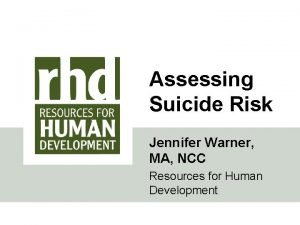Autistic Traits Future Thinking and Suicidality Mary E

- Slides: 1

Autistic Traits, Future Thinking and Suicidality Mary E. Stewart 1, Kym Craig 1, Rory O’Connor 2 and Stephanie Lee 1 1 Heriot Watt University, 2 University of Glasgow Background Suicide is one of the eading causes f lobal eaths. The WHO predict over 1 million deaths/year due to suicide by 2030 (WHO, 2017) approximately one death every 30 seconds. Those with higher levels of autistic traits are more at risk of suicidal thoughts and behaviours (Cassidy et al. , 2020; Pelton & Cassidy, 2017). Levels of positive future thinking are associated with suicidal thoughts and behaviour (e. g. O’Connor et al. , 2015). Scene construction may be an Researchelement questions important in the ability to think about the future (Lind &with Are autistic traits associated Williams, suicidal 2014). thoughts and behavours (STB), depressive symptoms, positive future thinking, and scene construction ability? Are autistic traits associated with levels of STB through levels of future thinking and/or depressive symptoms? Method Participants 51 participants (aged 18 -35, 7 males, 42 females, and 2 non-binary). Cross-sectional online survey. Autism-Spectrum Quotient (AQ) (Baron-Cohen et al. , 2001). Future Thinking (Mac. Leod & Byrne, 1996) adapted for online use Scene Construction (Hassabis et al. , 2007) Scale for Suicidal Ideation (SSI) (Beck et al. , 1988) Patient Health Questionnaire (PHQ) (Spitzer et al. , 2001) Contact information Email: : m. e. stewart@hw. ac. uk Website: www. simhw. ac. uk Twitter: @Mary. Stewart. Ed Results Autistic Traits Suicidal ideation Autistic Traits +ve future thinking -ve future thinking Depression +ve future thinking -0. 64** -0. 35* -0. 34* -ve future thinking 0. 00 -0. 06 -0. 34* Depression 0. 85 Scene Construc tion -0. 03 0. 60** -0. 20 -0. 36* 0. 16 -0. 10 0. 04 -0. 02 Linear Regression Autistic traits (AQ, β = 0. 19) and depressive symptoms (PHQ, β = 0. 75) predicted suicidal ideation scores, however, positive future thinking did not. Discussion Absence of positive future thinking was associated with depression, suicidal ideation and autistic traits. Presence of negative future thinking was not. Scene construction was not related to future thinking. Depressive symptoms are the highest predictor of suicidal ideation. Autistic traits are independently predictive of suicidal ideation when mood is taken into account. Public Involvement This project was inspired by a conversation with a father of an autistic boy who had committed suicide. All aspects of the project were guided by an individual with lived experience of mental health issues. References Baron-Cohen, S. et al 2001 JADD 31, 5– 17. https: //doi. org/10. 1023/A: 1005653411471 Beck A, T. , et al. 1988 J. Clin. Psychol, 47, 499 -505. Cassidy, S. A. et al. 2020 JADD 50, 3445– 3449. https: //doi. org/10. 1007/s 10803 -02004643 -9 Hassabis, D. 2007 J. Neurosci 27, 14365 -14374. O'Connor, R. C. 2015 J Consult Clin Psychol, 83, 169– 176. Mac. Leod, A. K. , & Byrne, A. 1996 J. Abnorm. Psychol. 105, 286 -289. Pelton, M. K. , & Cassidy, S. A. 2017 Autism Res, 10, 1891– 1904. https: //doi. org/10. 1002/aur. 1828 Spitzer, R. L. et al. 2001 J Gen Intern Med, 16, 606 -613.

